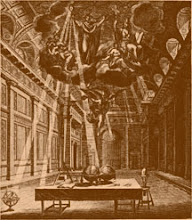One of the most important and yet often overlooked aspects of balanced Masonry is the art of proper leadership. There are several hundreds of books on leadership, all varying in style from the very basic to advanced techniques from eastern philosophers. One common theme seems to be that leadership starts from within, as a tiny seed that we can either grow, or let sit dormant. Experts agree that while some leaders posses the skills that make it easier to lead, true leaders are not born, they are developed.
So what makes a great Masonic leader? It starts with that small seed within us. First and foremost, we need to honestly love and care about what we do. It is an honest desire to do well that starts the seed growing. Someone wrote that true Masonic leaders don’t relay the message, they are the message. Wanting to succeed and do a good job is the very basis for successful leadership. That is why the men who we choose to lead our lodges must want to sit in the chair of Worshipful Master. The mentality of drawing straws to see whose turn it is to sit in the East is recipe for disaster. The lesson of the lesser lights in the first degree illustrates the personal growth that is the foundation of all future leadership skills. In “The Meaning of Masonry”, William Wilmhurst writes that the three lesser lights represent the sun, moon, and Master of the lodge. “The Master of the lodge,” Wilmhurst writes, “is the candidate himself and the lodge is his personal temple and well being.” The lesser lights illuminate the Holy Bible, Square and Compasses. The sunlight rules the day, the moonlight governs the night. The Mason therefore, is to govern his personal temple with the same zeal and fervor, enlightening and growing that seed of personal growth that lies within. That these lesser lights illuminate our three great lights, shows the importance of personal development.
The next important step in leadership development is that of education. Education in this sense is not that of the deep philosophies of Masonry or even the admission ceremonies of the three degrees. A newly elected Master of his lodge, or even the line officers as they progress through the chairs, should have a great working knowledge of his jurisdiction’s Masonic code, and of the customs of the lodge. It is important to have a working knowledge of Masonic law so that when the occasion arises, all issues are handled in a timely manner. The customs of the lodge are important to know as well. Knowing who to turn to in handling key events such as dinners and paying the taxes, will give the leader the extra time to focus on the important things in Masonry. All Masonic leaders should be able to flawlessly open and close the Masonic lodge equal to the position that they hold in the lodge. This will ensure that when a brother is elected to the office of Worshipful Master, he can not only open and close his lodge flawlessly, but will be able to coach his junior officers so that in turn when they progress through the chairs, they may do the same.The last and perhaps most important aspect of leadership is that of the personal interaction with the brethren. It is important to remember that if we lead and no one follows we are doing nothing more than going for a walk. A leadership position is first and foremost responsibility not to be taken lightly. Every brother wants to feel that their position on issues are wanted and respected, whether they are agreed with or not. Simply put, brethren who do not feel valued will not turn out for lodge functions and events. Be assured that for every brother that will voice his concerns for an uncaring leader, there will be several silent complainers who will simply stay home. When an overzealous leader starts strutting his stuff, because it is his year, and the gavel drops to end his meeting, and the apron and jewel come off, he will no longer lead his men. They simply will not allow it. A good leader will be in charge whether he is sitting in the big chair or slicing potatoes. A good example of this is the string test. Lay a string in a table. With the string laid out push one end of it with towards the other end. The result will be a crumpled up pile of string. Going the other way however, the string extended will follow your finger wherever it is moved on the table. Are we pushing or leading? Are we leading using the working tools of a Mason, or are we prodding our men along with the Tyler’s sword?
There is no simple way towards leadership development, but with these simple steps, our leaders will have the desire to do the job well, the knowledge to communicate and share their vision, and the tact and compassion towards their brethren to get the results. A great entrepreneur of the 20th century, Ray Kroc said it best. “None of us is a good as all of us”
used by permission of the author
Friday, January 18, 2008
Leadership Development, by R.W. Bro. Errol Hinton
Posted by
The Sanctum Sanctorum
at
1/18/2008 05:46:00 AM
![]()
![]()
Labels: Errol Hinton, leadership development, William Wilmhurst
Subscribe to:
Post Comments (Atom)


No comments:
Post a Comment